

11. Plan of the City of Lowell, Massachusetts, 1850
Sidney and Neff , 1850
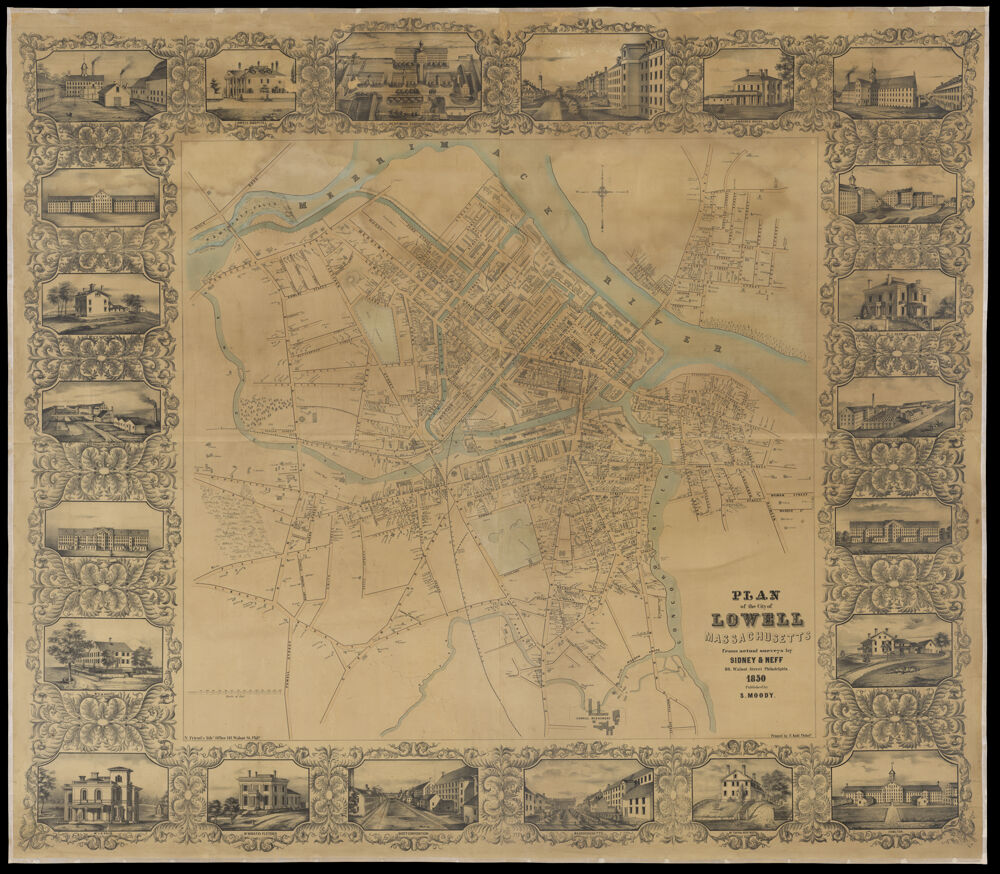
Click on image to see larger version.
The city of Lowell, Massachusetts, as depicted in this newly restored 1850 wall map, had a population of 30,000, making it the second largest city in Massachusetts and the largest industrial community in the United States. Located about 25 miles northwest of Boston, at the junction of the Merrimack and Concord rivers, and on a canal that bypassed the Merrimack River’s Pawtucket Falls, Lowell, then a part of North Chelmsford, was incorporated in 1826 by a group of Boston financiers known as the Boston Associates, who were looking to further expand the development of textile mills. As the nation’s first planned company mill town, the town was named for financier and industrialist Francis Cabot Lowell. The town of Lowell experienced unprecedented growth in the 1820s and 1830s; the Boston and Lowell Railroad was completed in 1835. By 1836, when Lowell became just the third city chartered in Massachusetts, the population had risen to 18,000.
The primary focus of “the spindle city’s” industry was textiles, highlighted by the thirteen factories depicted in the map’s marginal illustrations. These were integrated mills, combining spinning, weaving, bleaching, and dyeing within one complex. Using cotton imported from the South, picked and processed by enslaved men and women, the mills first employed mostly single women from the surrounding New England countryside as part of an enterprise known as the “Lowell Experiment.” These “mill girls” were eventually replaced by Irish immigrants in the 1830s and 1840s, and then later by French Canadian, Portuguese, and Eastern and Southern European immigrant laborers. The textile industry peaked in Lowell in the mid-1920s.
12. Merrimack Mfg. Co. (Cotton Mill & Print Works), Lowell, Mass., (#5727), surveyed January 11, 1900; amended September 28, 1905, and October 26, 1910
Associated Mutual Insurance Companies , 1910

Click on image to see larger version.
Merrimack Manufacturing Company Founded in 1824, the Merrimack Manufacturing Company was the first textile mill built in Lowell. It was funded and planned by the Boston Associates, who had previously developed the first integrated textile mill in Waltham, just west of Boston, in 1814. Based on that success, they secured land at the falls of the Merrimack River for construction of a much larger complex. This section of the exhibit includes two perspective views that demonstrate how this complex grew. The first example is the top center marginal illustration of the adjacent 1850 map of Lowell. At that time, the mill complex consisted of a half dozen multi-story buildings.
This perspective view, published by the Associated Mutual Insurance Companies, reflects changes that occurred up to 1910. The complex consisted of at least three dozen interconnected buildings accentuated by two smokestacks marking the addition of steam to the original waterpower. Detailed text on an accompanying site plan reports that the extant buildings date from the 1820s-1840s, with substantial additions up to 1910. By this time, however, the company’s fortunes began to decline as the textile industry moved to the South. The company was able to survive the Great Depression and World War II with government contracts and was one of the city’s last textile mills to cease operation. After the Merrimack Manufacturing Company closed in the late 1950s, most of the buildings were demolished for urban renewal.
13. Appleton Mills, Lowell, Mass., (#7519)
Barlow Insurance Surveys, undated
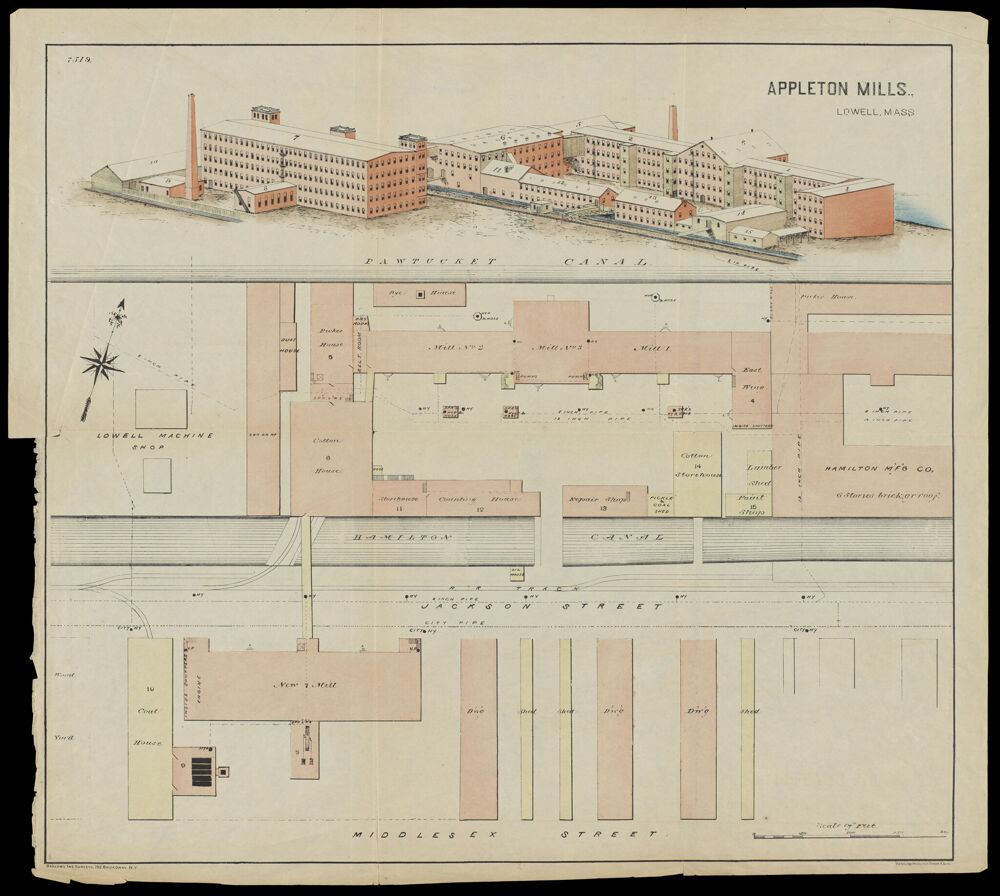
Click on image to see larger version.
Appleton and Boott Cotton Mills Spurred by Merrimack Manufacturing Company’s success, others quickly invested in Lowell’s industrial development. According to the adjacent city map, by 1850 there were at least 14 textile mills and related industries in operation throughout the city. Two of the mills included in the marginal illustrations, the Appleton and Boott mills, were subsequently mapped by the Barlow Insurance Surveys, as displayed here. Evidencing their expansion by the 1890s, both perspective views display a series of large connecting rectangular brick buildings, consisting of 2-5 stories, overshadowed by a smokestack. Tenements and dwellings for the mill workers are located nearby.
These two textile mills were named for Nathan Appleton and Kirk Boott, respectively. Appleton was one of the original members of the Boston Associates who planned the development of the Merrimack enterprise. Boott, also involved in the Boston Associates, became the company’s first agent and treasurer. Like other New England textile mills, the Appleton and Boott mills remained in operation until the early to mid-20th century. The Appleton complex has now been converted into apartments. The Boott complex, which remained fairly intact, now houses the Boott Cotton Mills Museum, administered as part of the Lowell National Historical Park by the National Park Service.
14. Boott Cotton Mills, Lowell, Mass., (#7379)
Barlow Insurance Surveys, undated
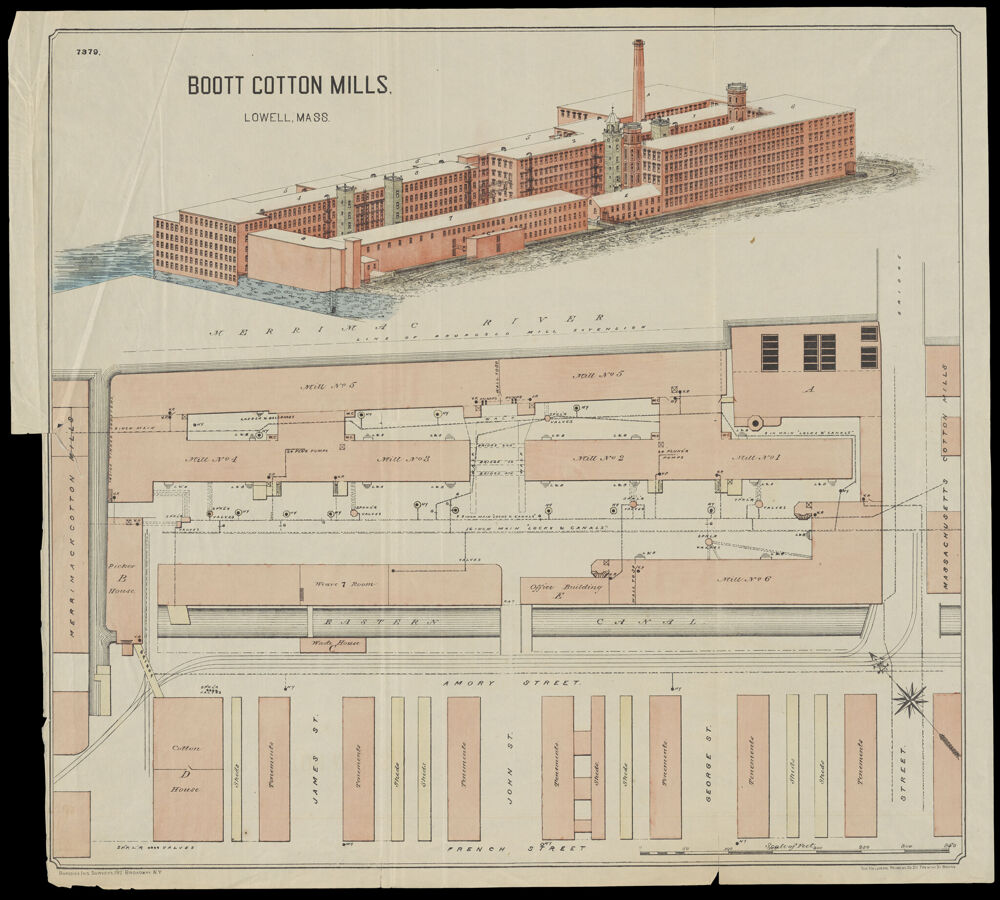
Click on image to see larger version.
15a. Plate 1
from Atlas of the City of Lowell, Massachusetts
L.J. Richards and Company, Cartographers , 1906
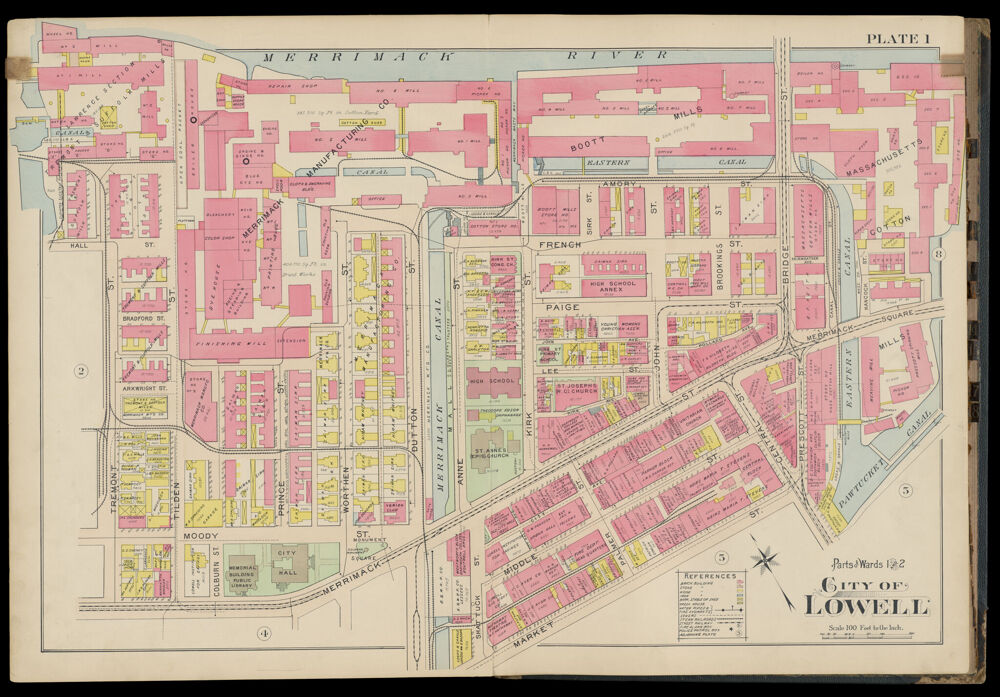
Click on image to see larger version.
While site-specific mill plans document single industrial properties, the more common urban fire insurance and real estate atlases provide coverage in multiple sheets for the entire built-up or “congested” areas of individual cities. These atlases show the footprint of each structure and are color coded to indicate construction materials: yellow (wood), red (brick), and blue (stone). Real estate atlases also include the names of property owners.
For example, this 1906 real estate atlas of Lowell provides coverage for the city of Lowell and several surrounding communities on 30 sheets, allowing an examination of the broader geographical context of the city’s industrial activity. On Plate1, shown here, there are three major mill complexes (Merrimack, Boott, and Massachusetts) adjacent to each other on the south shore of the Merrimack River. Just south of the Merrimack Mills are long narrow brick and wooden structures identified by owner’s names (Saiman Sirk and Hiram Whitney). These structures were tenements rented to the mill workers and their families. In the adjacent area, there are six churches of differing denominations, several schools, and numerous buildings devoted to business, government, and social activities. Taken together, they represent and constitute the rich social and community life that developed in proximity to the mills.
15b. Plate 3
from Atlas of the City of Lowell, Massachusetts
L.J. Richards and Company, Cartographers , 1896
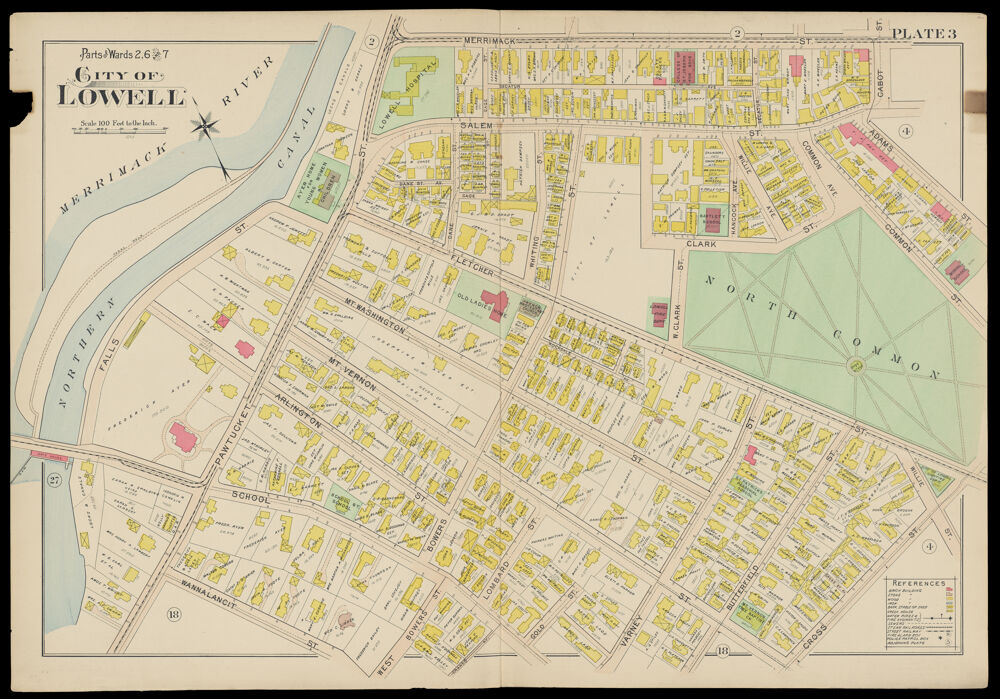
Click on image to see larger version.
Similar in style to the 1906 Lowell atlas on the opposite side of this case, this 1896 real estate atlas of Lawrence, Massachusetts, maps the city on 22 sheets, providing a broader context for the city’s industrial activity and the setting for the 1912 labor strike. On Plate 3, there are three major mill complexes (Washington, Lawrence Duck, and Pemberton) adjacent to each other on the north shore of the Merrimack River, between the river and North Canal. On the north side of the canal, there are tenements for Washington and Pemberton worker families. Everett Mills, where the strike began, is located at the juncture of the Spicket River and North Canal. In the adjacent area, there are several other industries, including woolen and paper mills, a foundry, and a tool shop. This area also included numerous dwellings, two schools, and four churches. The church located across Union Street from the Everett Mills’ entrance was the Holy Rosary Roman Catholic Church, where the Italians worshiped. Their priest, Father Mariano Milanese, who was not particularly supportive of the unions, offered his parishioners food and other necessities during the strike.
16a. New Tenements, Prince Street, Lowell, Massachusetts
Merrimack Manufacturing Company , 1880
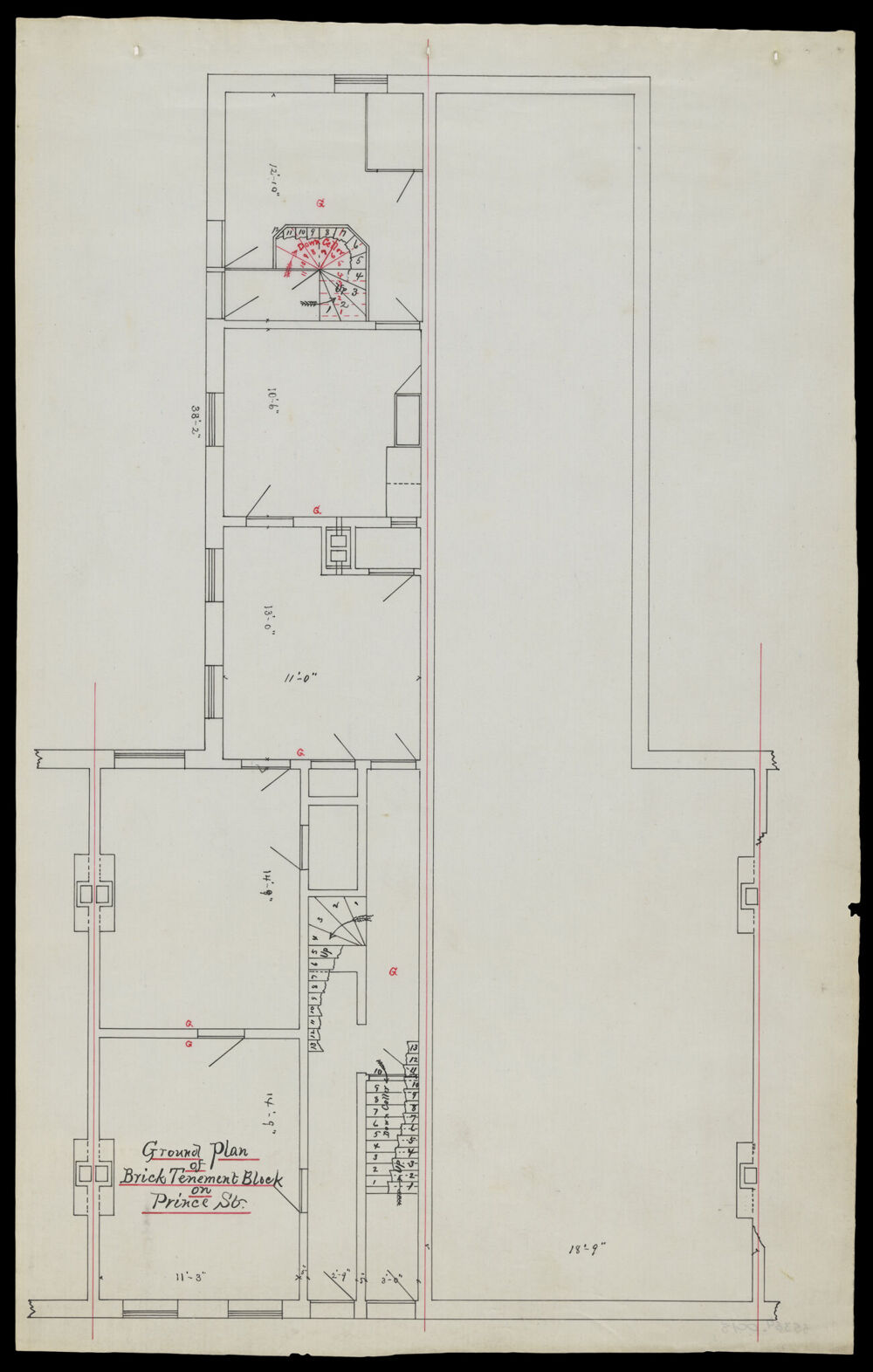
Click on image to see larger version.
Merrimack Manufacturing Company was the first textile manufacturing concern to open in Lowell, beginning in 1823. The construction included canals, a machine shop, dyehouse and boarding houses for the operatives. In 1960, the entire complex was demolished for urban renewal. Many of the tenements were taken down as well. The hand-drawn plans on display show tenement houses that were constructed on Prince Street by the company in 1880. The 1906 Richards Atlas of the City of Lowell (on display in the middle case) indicates that many of the Prince Street tenements were owned by Saiman Sirk, a Slovenian property owner. The footprint of Sirk’s tenements on Prince Street can also be seen in the adjacent Merrimack site plan which was surveyed in 1900. In an excerpt from a 1901 newspaper, Sirk is cited for concluding “another Big Deal with the Boot Mills.” The article also indicated that he was the “owner of more mill tenements than any other man in Lowell” and “he will be the owner of property in Lowell valued at almost a million dollars.”
16b. New Tenements, Prince Street, Lowell, Massachusetts
Merrimack Manufacturing Company , 1880
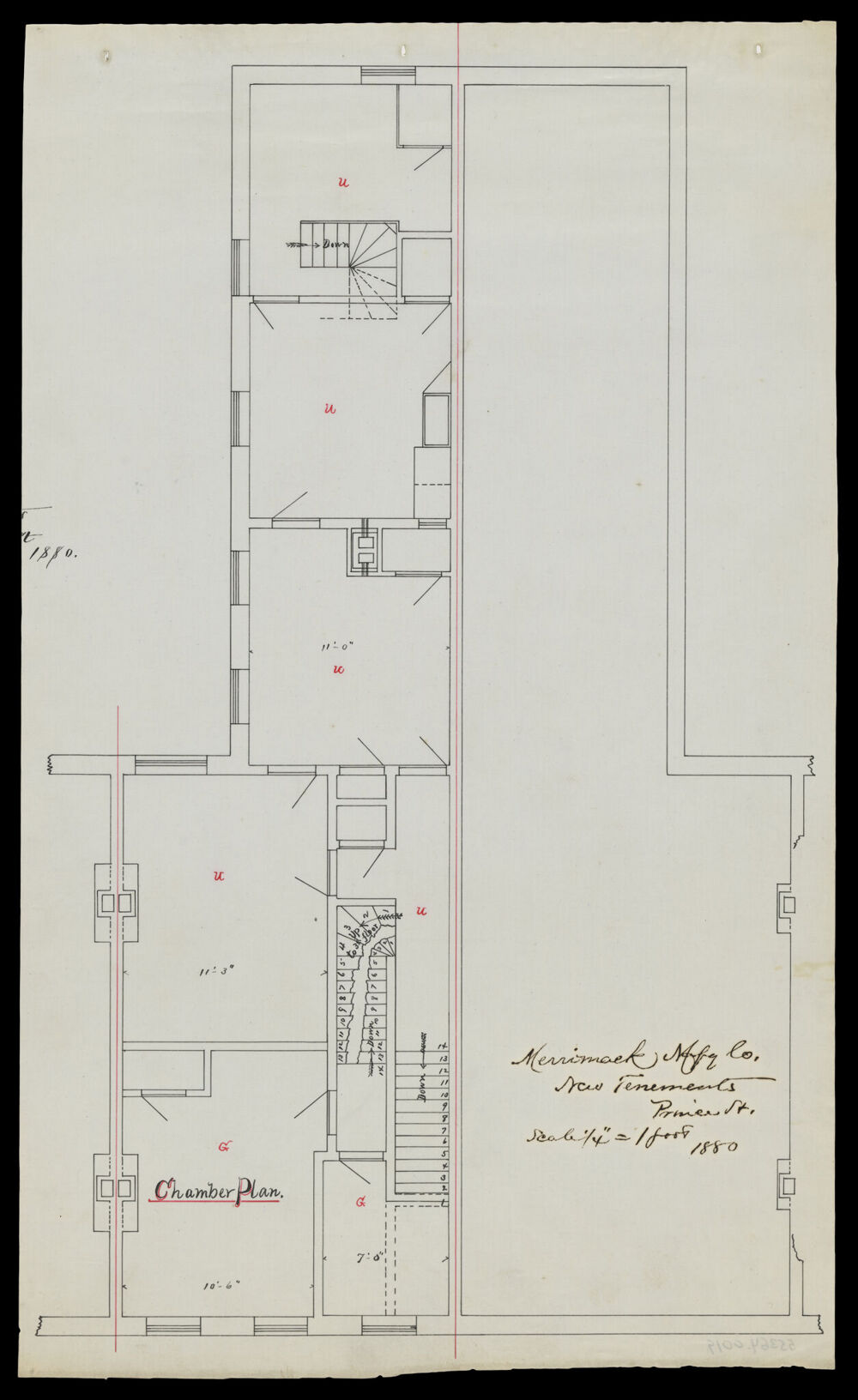
Click on image to see larger version.